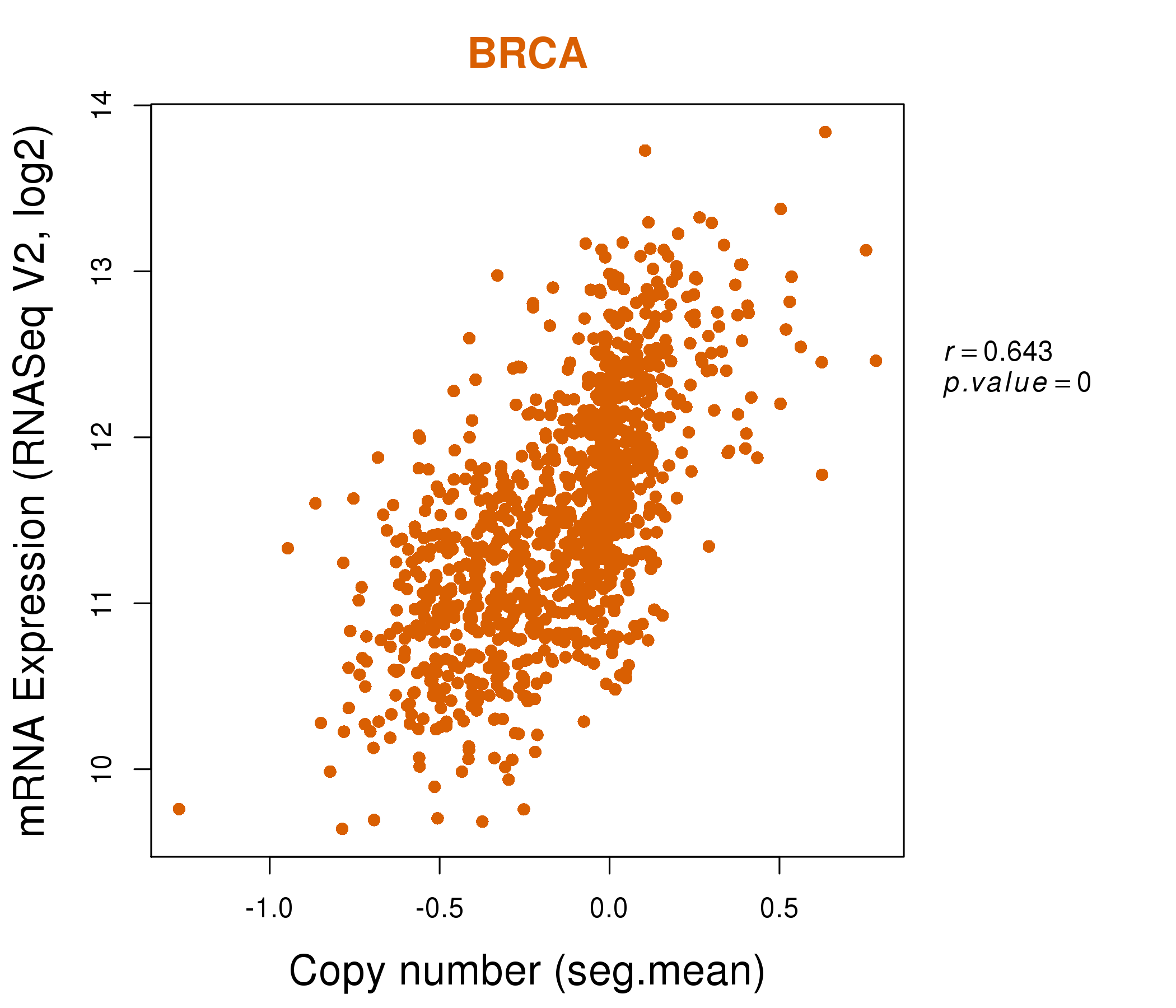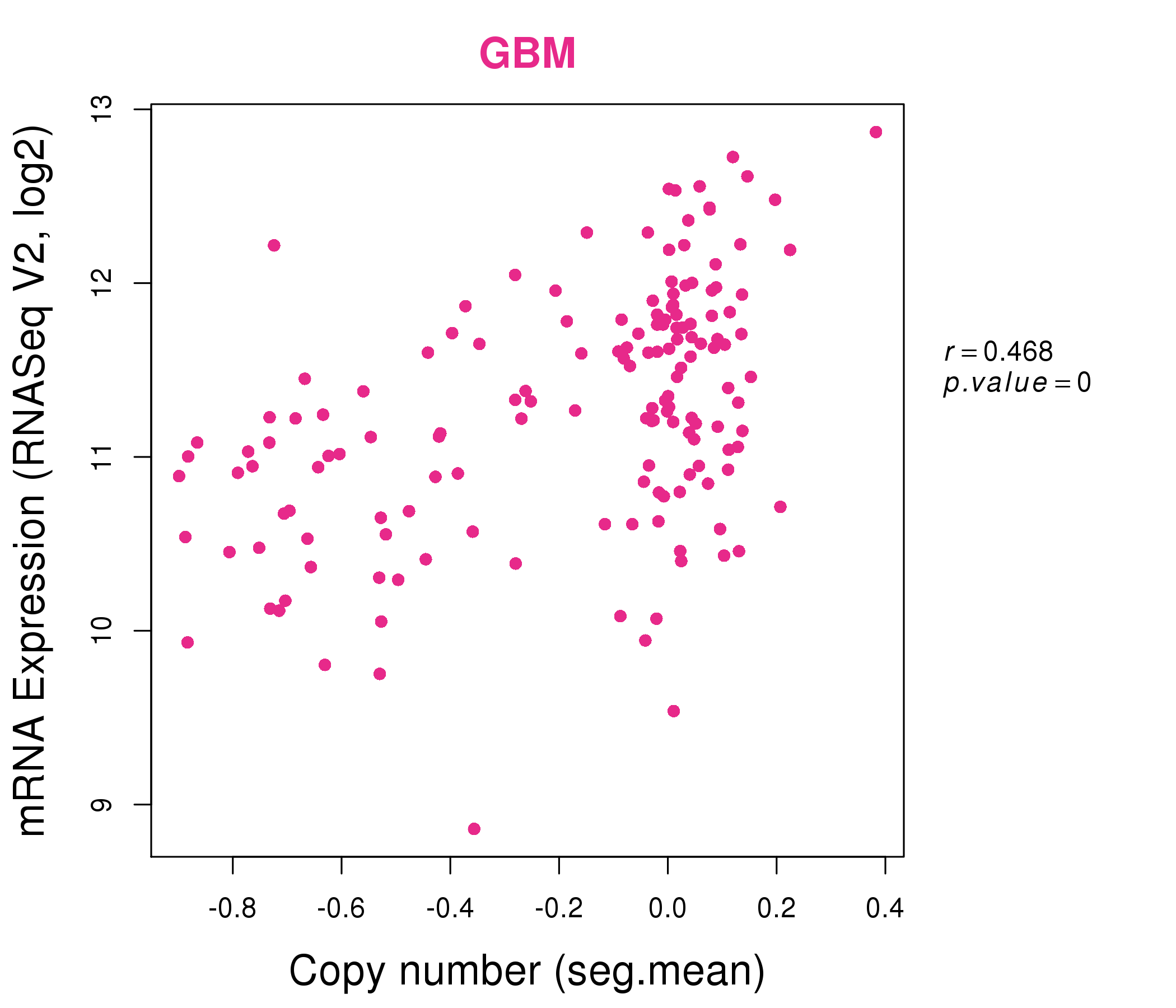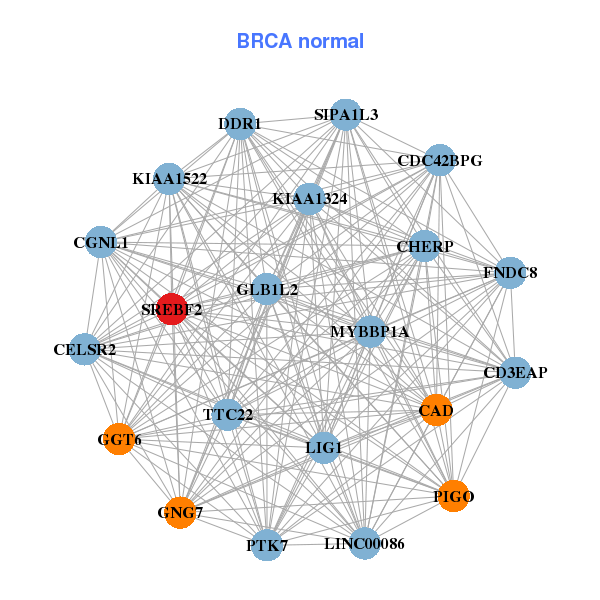|
|||||||||||||||||||||||||||||||||||||||||||||||||||||||||||||||||||||||||||||||||||||||||||||||||||||||||||||||||||||||||||||||||||||||||||||||||||||||||||||||||||||||||||||||||||||||||||||||||||||||||||||||||||||||||||||||||||||||||||||||||||||||||||||||||||||||||||||||||||||||||||||||||||||||||||||||||||||||||||||||||||||||||||||||||||
| |
| Phenotypic Information (metabolism pathway, cancer, disease, phenome) |
| |
| |
| Gene-Gene Network Information: Co-Expression Network, Interacting Genes & KEGG |
| |
|
| Gene Summary for SREBF2 |
| Basic gene info. | Gene symbol | SREBF2 |
| Gene name | sterol regulatory element binding transcription factor 2 | |
| Synonyms | SREBP-2|SREBP2|bHLHd2 | |
| Cytomap | UCSC genome browser: 22q13 | |
| Genomic location | chr22 :42229105-42302375 | |
| Type of gene | protein-coding | |
| RefGenes | NM_004599.3, NR_103834.1, | |
| Ensembl id | ENSG00000198911 | |
| Description | class D basic helix-loop-helix protein 2sterol regulatory element-binding protein 2sterol regulatory element-binding transcription factor 2 | |
| Modification date | 20141207 | |
| dbXrefs | MIM : 600481 | |
| HGNC : HGNC | ||
| Ensembl : ENSG00000198911 | ||
| HPRD : 02726 | ||
| Vega : OTTHUMG00000151261 | ||
| Protein | UniProt: go to UniProt's Cross Reference DB Table | |
| Expression | CleanEX: HS_SREBF2 | |
| BioGPS: 6721 | ||
| Gene Expression Atlas: ENSG00000198911 | ||
| The Human Protein Atlas: ENSG00000198911 | ||
| Pathway | NCI Pathway Interaction Database: SREBF2 | |
| KEGG: SREBF2 | ||
| REACTOME: SREBF2 | ||
| ConsensusPathDB | ||
| Pathway Commons: SREBF2 | ||
| Metabolism | MetaCyc: SREBF2 | |
| HUMANCyc: SREBF2 | ||
| Regulation | Ensembl's Regulation: ENSG00000198911 | |
| miRBase: chr22 :42,229,105-42,302,375 | ||
| TargetScan: NM_004599 | ||
| cisRED: ENSG00000198911 | ||
| Context | iHOP: SREBF2 | |
| cancer metabolism search in PubMed: SREBF2 | ||
| UCL Cancer Institute: SREBF2 | ||
| Assigned class in ccmGDB | C | |
| Top |
| Phenotypic Information for SREBF2(metabolism pathway, cancer, disease, phenome) |
| Cancer | CGAP: SREBF2 |
| Familial Cancer Database: SREBF2 | |
| * This gene is included in those cancer gene databases. |
|
|
|
|
|
| . | |||||||||||||||||||||||||||||||||||||||||||||||||||||||||||||||||||||||||||||||||||||||||||||||||||||||||||||||||||||||||||||||||||||||||||||||||||||||||||||||||||||||||||||||||||||||||||||||||||||||||||||||||||||||||||||||||||||||||||||||||||||||||||||||||||||||||||||||||||||||||||||||||||||||||||||||||||||||||||||||||||||||||||||
Oncogene 1 | Significant driver gene in | ||||||||||||||||||||||||||||||||||||||||||||||||||||||||||||||||||||||||||||||||||||||||||||||||||||||||||||||||||||||||||||||||||||||||||||||||||||||||||||||||||||||||||||||||||||||||||||||||||||||||||||||||||||||||||||||||||||||||||||||||||||||||||||||||||||||||||||||||||||||||||||||||||||||||||||||||||||||||||||||||||||||||||||||||||
| cf) number; DB name 1 Oncogene; http://nar.oxfordjournals.org/content/35/suppl_1/D721.long, 2 Tumor Suppressor gene; https://bioinfo.uth.edu/TSGene/, 3 Cancer Gene Census; http://www.nature.com/nrc/journal/v4/n3/abs/nrc1299.html, 4 CancerGenes; http://nar.oxfordjournals.org/content/35/suppl_1/D721.long, 5 Network of Cancer Gene; http://ncg.kcl.ac.uk/index.php, 1Therapeutic Vulnerabilities in Cancer; http://cbio.mskcc.org/cancergenomics/statius/ |
| REACTOME_METABOLISM_OF_LIPIDS_AND_LIPOPROTEINS | |
| OMIM | |
| Orphanet | |
| Disease | KEGG Disease: SREBF2 |
| MedGen: SREBF2 (Human Medical Genetics with Condition) | |
| ClinVar: SREBF2 | |
| Phenotype | MGI: SREBF2 (International Mouse Phenotyping Consortium) |
| PhenomicDB: SREBF2 | |
| Mutations for SREBF2 |
| * Under tables are showing count per each tissue to give us broad intuition about tissue specific mutation patterns.You can go to the detailed page for each mutation database's web site. |
| - Statistics for Tissue and Mutation type | Top |
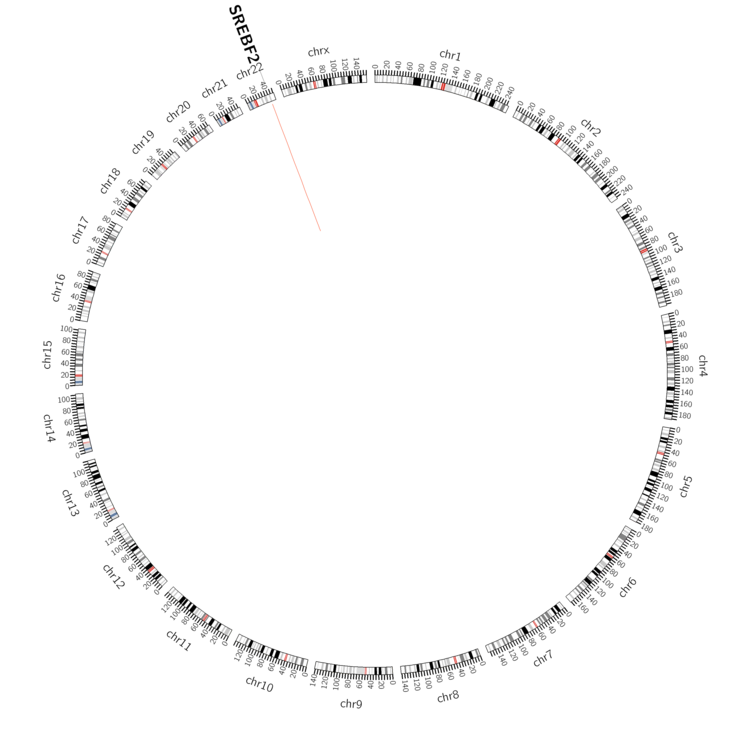 |
| - For Inter-chromosomal Variations |
| There's no inter-chromosomal structural variation. |
| - For Intra-chromosomal Variations |
| * Intra-chromosomal variantions includes 'intrachromosomal amplicon to amplicon', 'intrachromosomal amplicon to non-amplified dna', 'intrachromosomal deletion', 'intrachromosomal fold-back inversion', 'intrachromosomal inversion', 'intrachromosomal tandem duplication', 'Intrachromosomal unknown type', 'intrachromosomal with inverted orientation', 'intrachromosomal with non-inverted orientation'. |
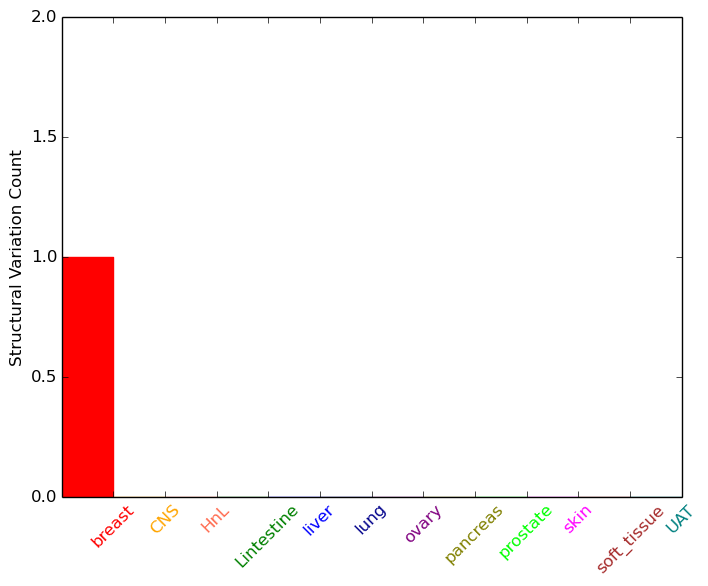 |
| Sample | Symbol_a | Chr_a | Start_a | End_a | Symbol_b | Chr_b | Start_b | End_b |
| breast | SREBF2 | chr22 | 42255801 | 42255801 | SREBF2 | chr22 | 42257372 | 42257372 |
| cf) Tissue number; Tissue name (1;Breast, 2;Central_nervous_system, 3;Haematopoietic_and_lymphoid_tissue, 4;Large_intestine, 5;Liver, 6;Lung, 7;Ovary, 8;Pancreas, 9;Prostate, 10;Skin, 11;Soft_tissue, 12;Upper_aerodigestive_tract) |
| * From mRNA Sanger sequences, Chitars2.0 arranged chimeric transcripts. This table shows SREBF2 related fusion information. |
| ID | Head Gene | Tail Gene | Accession | Gene_a | qStart_a | qEnd_a | Chromosome_a | tStart_a | tEnd_a | Gene_a | qStart_a | qEnd_a | Chromosome_a | tStart_a | tEnd_a |
| Top |
| Mutation type/ Tissue ID | brca | cns | cerv | endome | haematopo | kidn | Lintest | liver | lung | ns | ovary | pancre | prost | skin | stoma | thyro | urina | |||
| Total # sample | 1 | 1 | 2 | |||||||||||||||||
| GAIN (# sample) | 1 | 2 | ||||||||||||||||||
| LOSS (# sample) | 1 |
| cf) Tissue ID; Tissue type (1; Breast, 2; Central_nervous_system, 3; Cervix, 4; Endometrium, 5; Haematopoietic_and_lymphoid_tissue, 6; Kidney, 7; Large_intestine, 8; Liver, 9; Lung, 10; NS, 11; Ovary, 12; Pancreas, 13; Prostate, 14; Skin, 15; Stomach, 16; Thyroid, 17; Urinary_tract) |
| Top |
|
 |
| Top |
| Stat. for Non-Synonymous SNVs (# total SNVs=69) | (# total SNVs=29) |
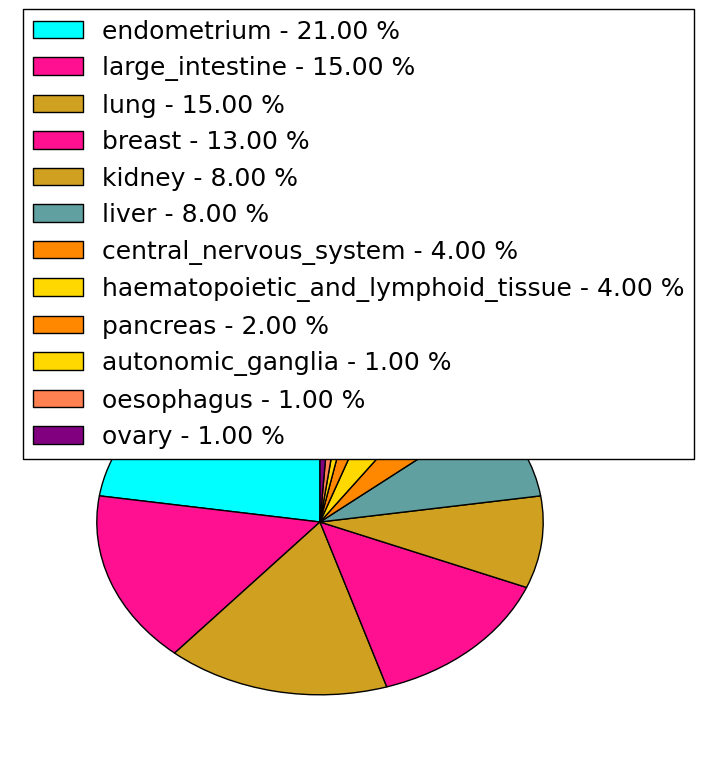 | 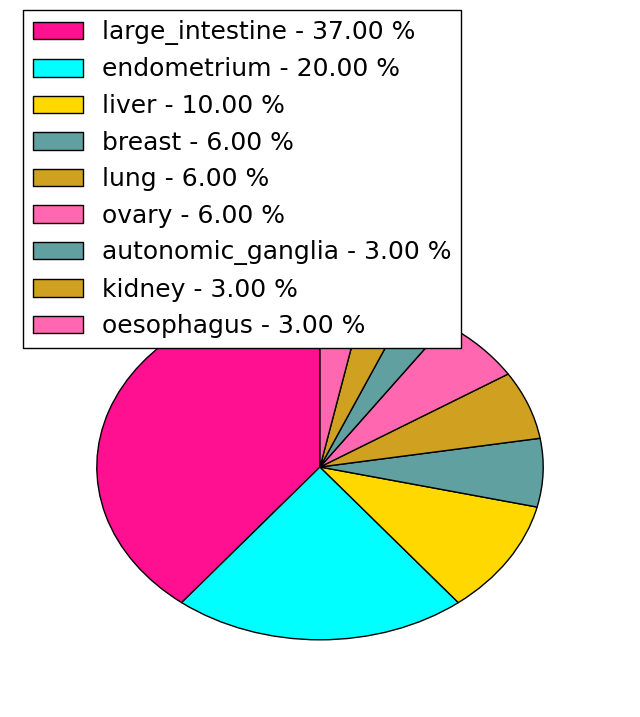 |
(# total SNVs=3) | (# total SNVs=2) |
 | 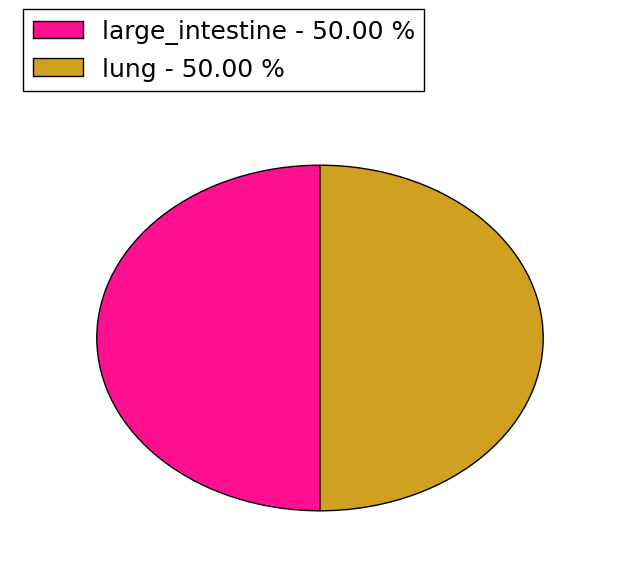 |
| Top |
| * When you move the cursor on each content, you can see more deailed mutation information on the Tooltip. Those are primary_site,primary_histology,mutation(aa),pubmedID. |
| GRCh37 position | Mutation(aa) | Unique sampleID count |
| chr22:42269825-42269825 | p.T297T | 3 |
| chr22:42262990-42262990 | p.G82* | 3 |
| chr22:42262862-42262862 | p.V39G | 2 |
| chr22:42299055-42299055 | p.V997L | 2 |
| chr22:42262864-42262864 | p.G40R | 2 |
| chr22:42263037-42263037 | p.L97L | 2 |
| chr22:42264766-42264766 | p.T230T | 2 |
| chr22:42276831-42276831 | p.R625C | 2 |
| chr22:42280950-42280950 | p.E715K | 2 |
| chr22:42293062-42293062 | p.F834F | 2 |
| Top |
|
 |
| Point Mutation/ Tissue ID | 1 | 2 | 3 | 4 | 5 | 6 | 7 | 8 | 9 | 10 | 11 | 12 | 13 | 14 | 15 | 16 | 17 | 18 | 19 | 20 |
| # sample | 3 | 3 | 17 | 1 | 3 | 4 | 1 | 3 | 3 | 2 | 1 | 15 | 8 | 1 | 15 | |||||
| # mutation | 3 | 3 | 15 | 1 | 3 | 4 | 1 | 3 | 3 | 2 | 1 | 15 | 9 | 1 | 21 | |||||
| nonsynonymous SNV | 3 | 3 | 6 | 1 | 3 | 3 | 1 | 2 | 2 | 1 | 1 | 6 | 7 | 1 | 15 | |||||
| synonymous SNV | 9 | 1 | 1 | 1 | 1 | 9 | 2 | 6 |
| cf) Tissue ID; Tissue type (1; BLCA[Bladder Urothelial Carcinoma], 2; BRCA[Breast invasive carcinoma], 3; CESC[Cervical squamous cell carcinoma and endocervical adenocarcinoma], 4; COAD[Colon adenocarcinoma], 5; GBM[Glioblastoma multiforme], 6; Glioma Low Grade, 7; HNSC[Head and Neck squamous cell carcinoma], 8; KICH[Kidney Chromophobe], 9; KIRC[Kidney renal clear cell carcinoma], 10; KIRP[Kidney renal papillary cell carcinoma], 11; LAML[Acute Myeloid Leukemia], 12; LUAD[Lung adenocarcinoma], 13; LUSC[Lung squamous cell carcinoma], 14; OV[Ovarian serous cystadenocarcinoma ], 15; PAAD[Pancreatic adenocarcinoma], 16; PRAD[Prostate adenocarcinoma], 17; SKCM[Skin Cutaneous Melanoma], 18:STAD[Stomach adenocarcinoma], 19:THCA[Thyroid carcinoma], 20:UCEC[Uterine Corpus Endometrial Carcinoma]) |
| Top |
| * We represented just top 10 SNVs. When you move the cursor on each content, you can see more deailed mutation information on the Tooltip. Those are primary_site, primary_histology, mutation(aa), pubmedID. |
| Genomic Position | Mutation(aa) | Unique sampleID count |
| chr22:42269825 | p.T297T | 3 |
| chr22:42263193 | p.S69G | 2 |
| chr22:42262951 | p.F834F | 2 |
| chr22:42293062 | p.L97L | 2 |
| chr22:42269956 | p.P122S | 2 |
| chr22:42263037 | p.R341Q | 2 |
| chr22:42263110 | p.T149T | 2 |
| chr22:42276831 | p.N347D | 1 |
| chr22:42271363 | p.P496P | 1 |
| chr22:42289188 | p.I716I | 1 |
| * Copy number data were extracted from TCGA using R package TCGA-Assembler. The URLs of all public data files on TCGA DCC data server were gathered on Jan-05-2015. Function ProcessCNAData in TCGA-Assembler package was used to obtain gene-level copy number value which is calculated as the average copy number of the genomic region of a gene. |
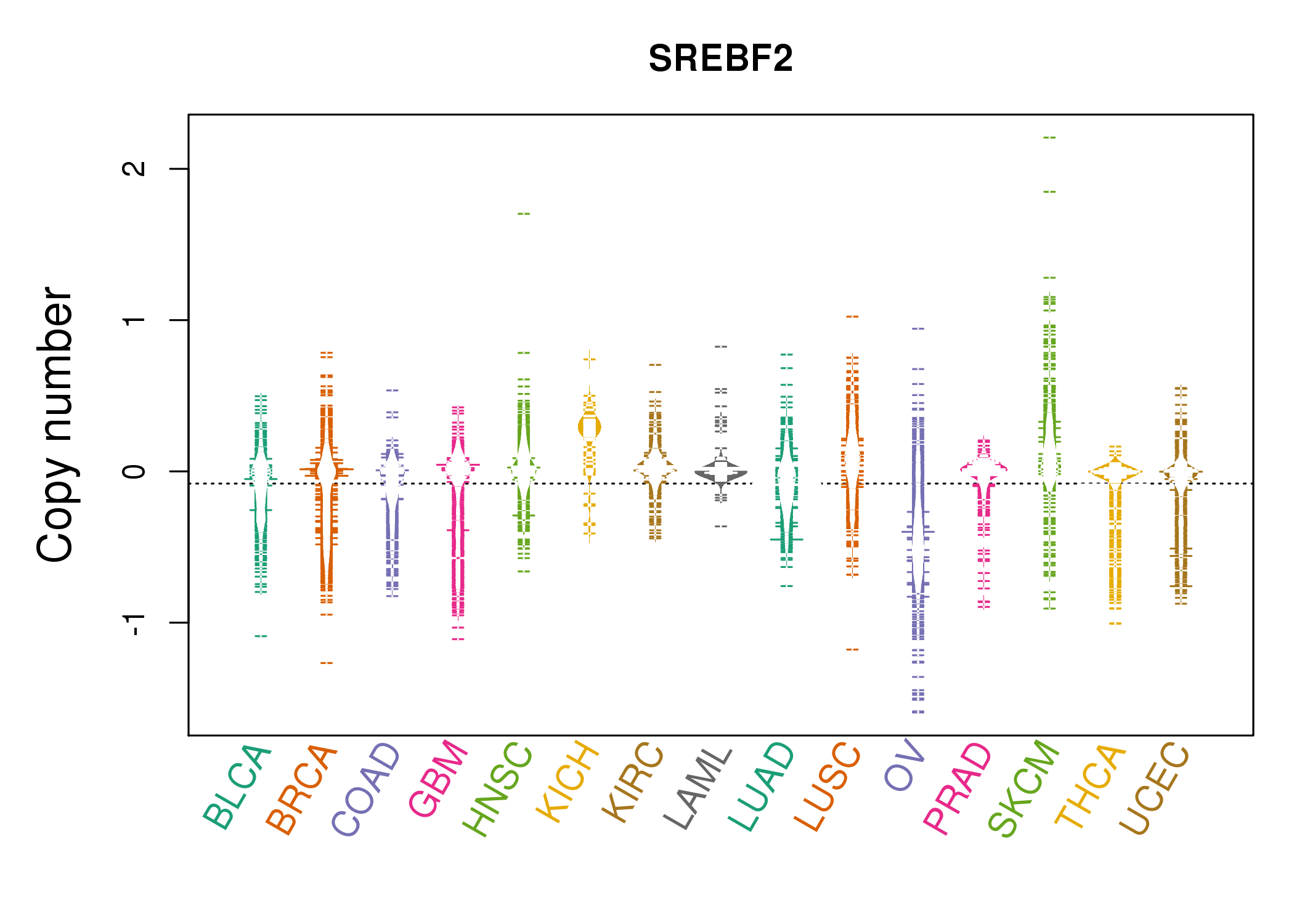 |
| cf) Tissue ID[Tissue type]: BLCA[Bladder Urothelial Carcinoma], BRCA[Breast invasive carcinoma], CESC[Cervical squamous cell carcinoma and endocervical adenocarcinoma], COAD[Colon adenocarcinoma], GBM[Glioblastoma multiforme], Glioma Low Grade, HNSC[Head and Neck squamous cell carcinoma], KICH[Kidney Chromophobe], KIRC[Kidney renal clear cell carcinoma], KIRP[Kidney renal papillary cell carcinoma], LAML[Acute Myeloid Leukemia], LUAD[Lung adenocarcinoma], LUSC[Lung squamous cell carcinoma], OV[Ovarian serous cystadenocarcinoma ], PAAD[Pancreatic adenocarcinoma], PRAD[Prostate adenocarcinoma], SKCM[Skin Cutaneous Melanoma], STAD[Stomach adenocarcinoma], THCA[Thyroid carcinoma], UCEC[Uterine Corpus Endometrial Carcinoma] |
| Top |
| Gene Expression for SREBF2 |
| * CCLE gene expression data were extracted from CCLE_Expression_Entrez_2012-10-18.res: Gene-centric RMA-normalized mRNA expression data. |
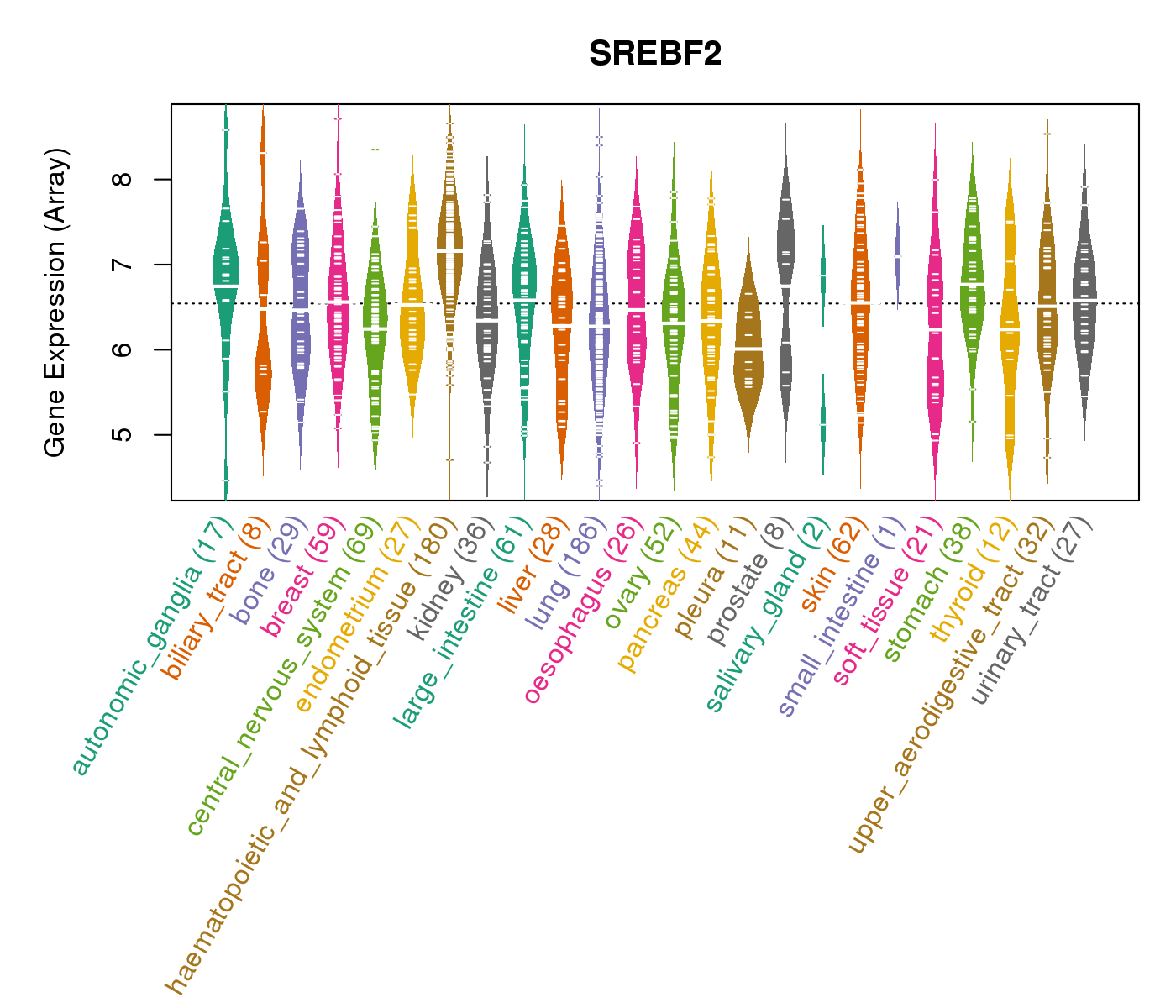 |
| * Normalized gene expression data of RNASeqV2 was extracted from TCGA using R package TCGA-Assembler. The URLs of all public data files on TCGA DCC data server were gathered at Jan-05-2015. Only eight cancer types have enough normal control samples for differential expression analysis. (t test, adjusted p<0.05 (using Benjamini-Hochberg FDR)) |
 |
| Top |
| * This plots show the correlation between CNV and gene expression. |
: Open all plots for all cancer types
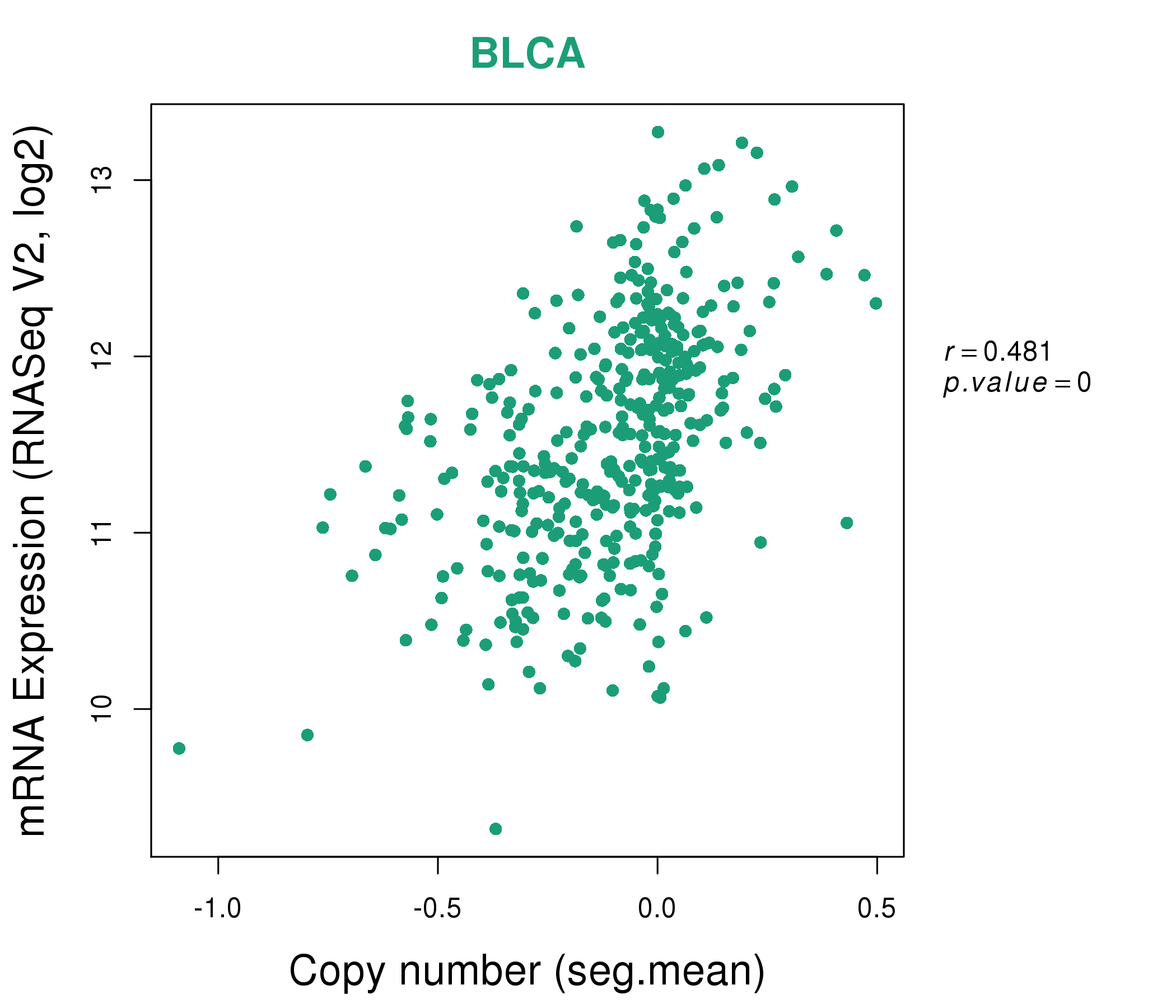 |
|
 |
|
| Top |
| Gene-Gene Network Information |
| * Co-Expression network figures were drawn using R package igraph. Only the top 20 genes with the highest correlations were shown. Red circle: input gene, orange circle: cell metabolism gene, sky circle: other gene |
: Open all plots for all cancer types
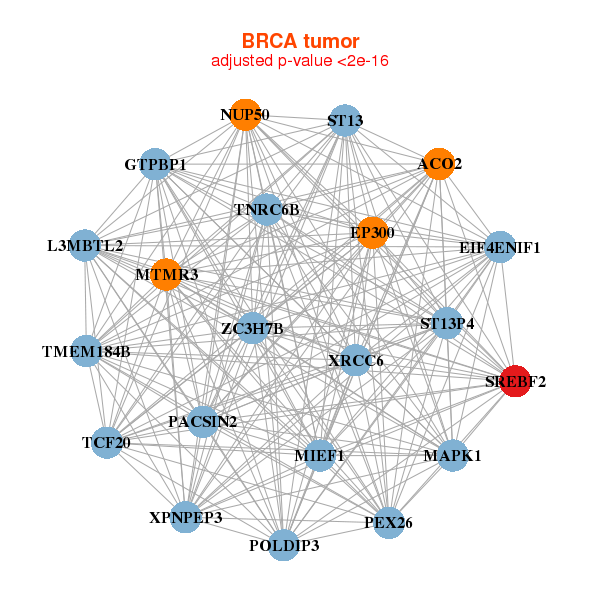 |
| ||||
| ACO2,EIF4ENIF1,EP300,ST13P4,GTPBP1,L3MBTL2,MAPK1, MTMR3,NUP50,PACSIN2,PEX26,POLDIP3,MIEF1,SREBF2, ST13,TCF20,TMEM184B,TNRC6B,XPNPEP3,XRCC6,ZC3H7B | CAD,CD3EAP,CDC42BPG,CELSR2,CGNL1,CHERP,DDR1, FNDC8,GGT6,GLB1L2,GNG7,KIAA1324,KIAA1522,LIG1, MYBBP1A,LINC00086,PIGO,PTK7,SIPA1L3,SREBF2,TTC22 | ||||
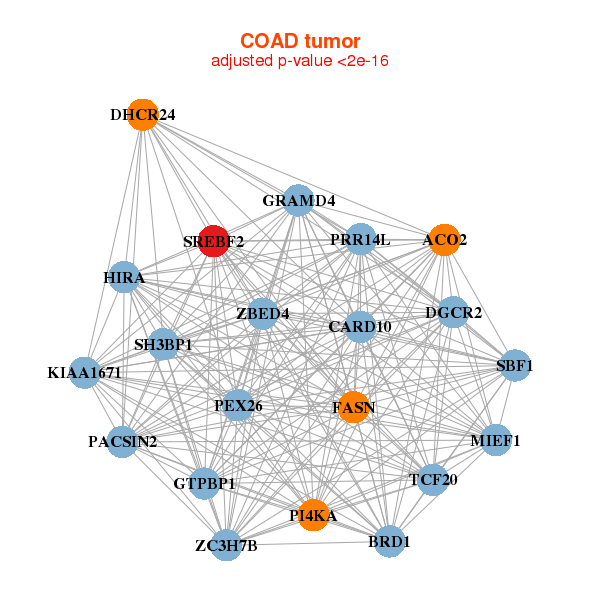 |
| ||||
| ACO2,BRD1,PRR14L,CARD10,DGCR2,DHCR24,FASN, GRAMD4,GTPBP1,HIRA,KIAA1671,PACSIN2,PEX26,PI4KA, SBF1,SH3BP1,MIEF1,SREBF2,TCF20,ZBED4,ZC3H7B | PRR14L,CLIP2,EDC4,IGF2R,KIF13B,MAVS,MINK1, MYH9,MYO18A,PIK3C2B,PLCE1,PLEKHA6,PLEKHM1,PTPRF, RREB1,SCAP,SIPA1L3,SLC44A2,SLC9A1,SREBF2,TMEM131 |
| * Co-Expression network figures were drawn using R package igraph. Only the top 20 genes with the highest correlations were shown. Red circle: input gene, orange circle: cell metabolism gene, sky circle: other gene |
: Open all plots for all cancer types
| Top |
: Open all interacting genes' information including KEGG pathway for all interacting genes from DAVID
| Top |
| Pharmacological Information for SREBF2 |
| DB Category | DB Name | DB's ID and Url link |
| * Gene Centered Interaction Network. |
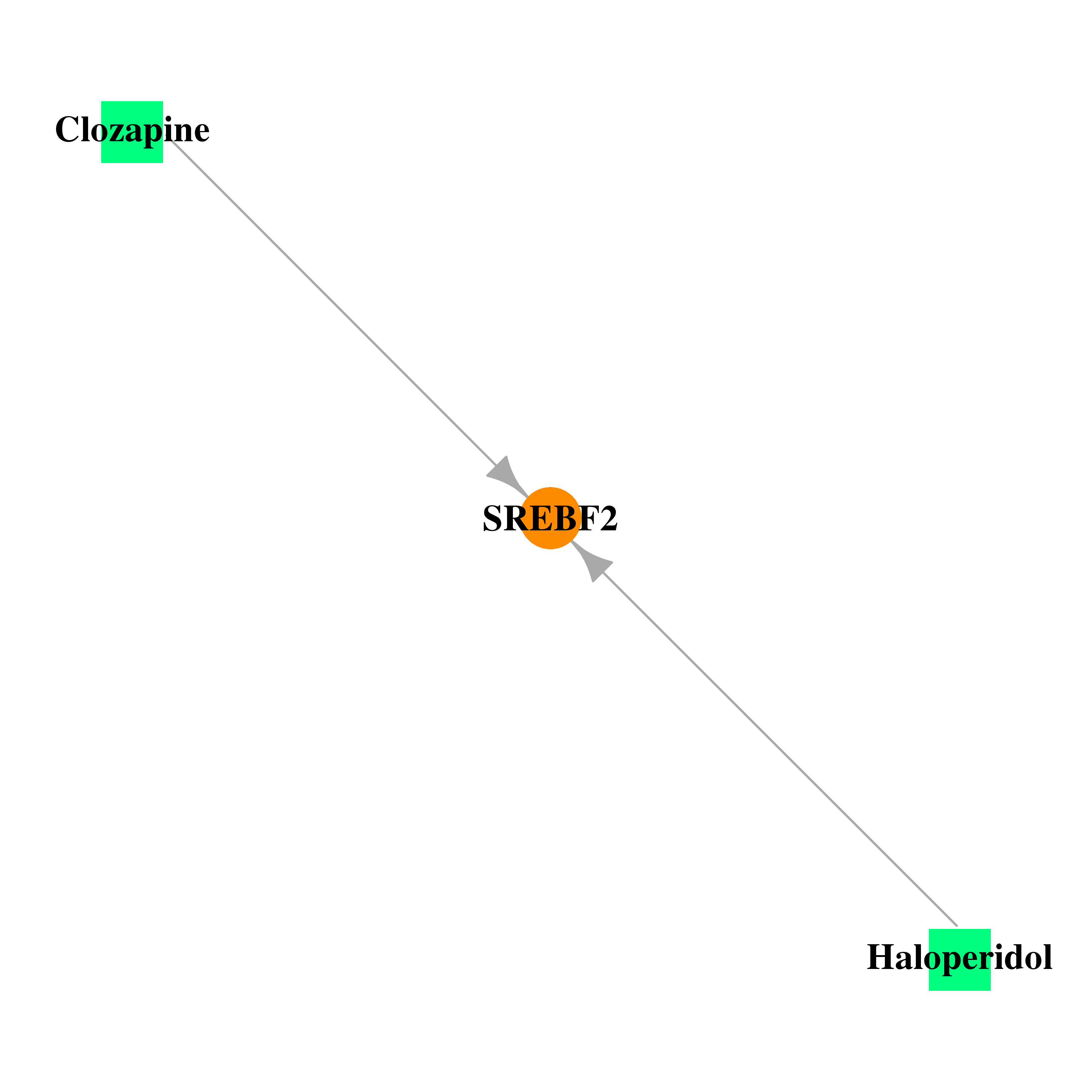 |
| * Drug Centered Interaction Network. |
| DrugBank ID | Target Name | Drug Groups | Generic Name | Drug Centered Network | Drug Structure |
| DB00363 | sterol regulatory element binding transcription factor 2 | approved | Clozapine | 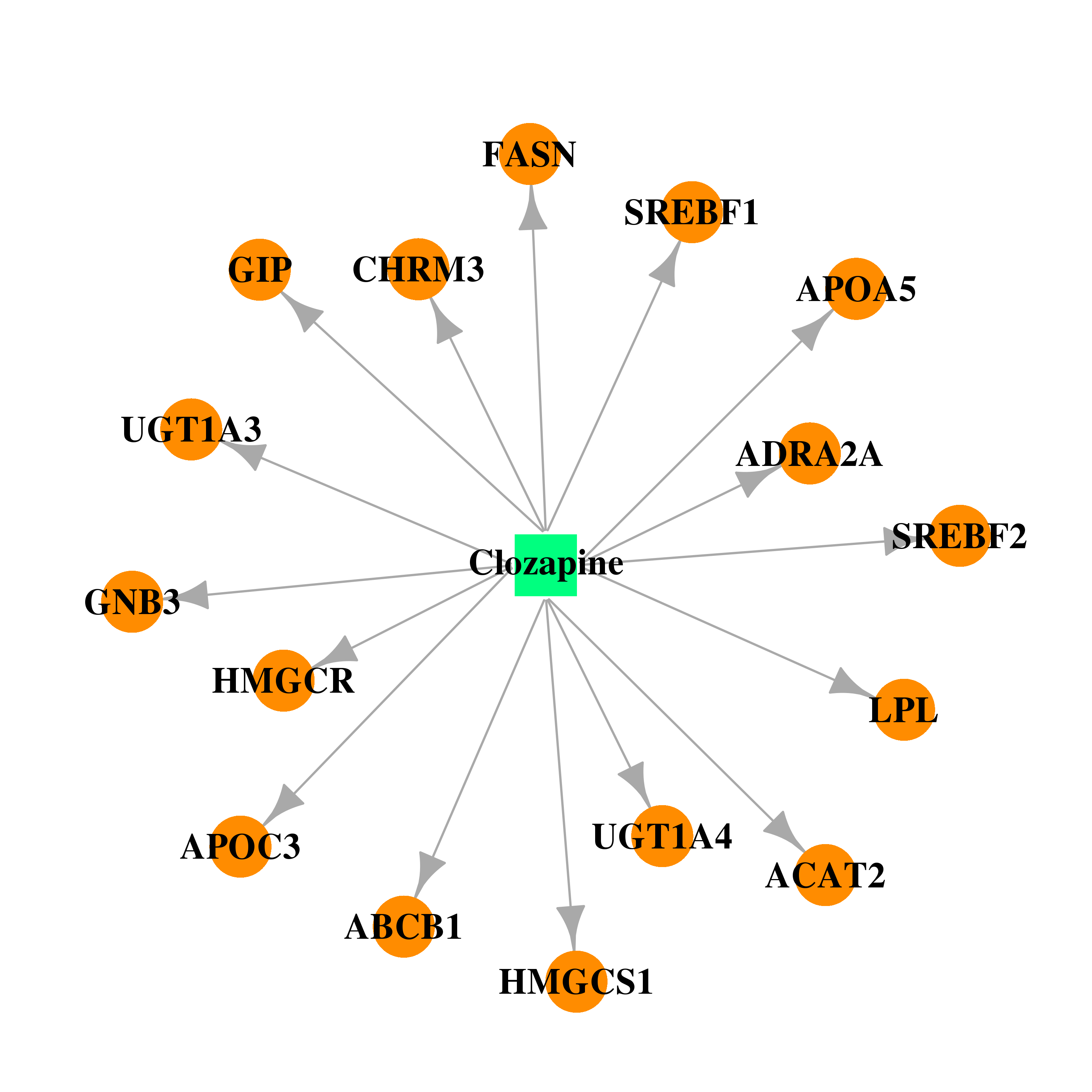 |  |
| DB00502 | sterol regulatory element binding transcription factor 2 | approved | Haloperidol |  | 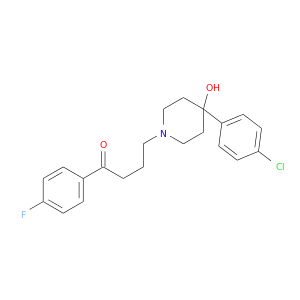 |
| Top |
| Cross referenced IDs for SREBF2 |
| * We obtained these cross-references from Uniprot database. It covers 150 different DBs, 18 categories. http://www.uniprot.org/help/cross_references_section |
: Open all cross reference information
|
Copyright © 2016-Present - The Univsersity of Texas Health Science Center at Houston @ |






